MBA Research Report: Electronic Transactions and Household Expenditure
VerifiedAdded on 2022/10/12
|13
|3234
|9
Report
AI Summary
This MBA research report investigates the influence of electronic transactions and credit-based payment methods, particularly credit cards and 'pay-later' services like Afterpay, on Australian household spending habits and the broader economy. The report begins by establishing the context of Australia's mixed-market economy and the prevalence of cashless transactions. It then examines the impact of these payment methods on various aspects, including the economy, household expenditure patterns, production, and merchants. A critical analysis is conducted to assess the effects of increased consumption on product waste and the potential negative consequences of reckless credit use, including rising household debt and financial stress. The report concludes with proposed measures to mitigate these negative impacts, offering insights into the evolving landscape of consumer finance in Australia.
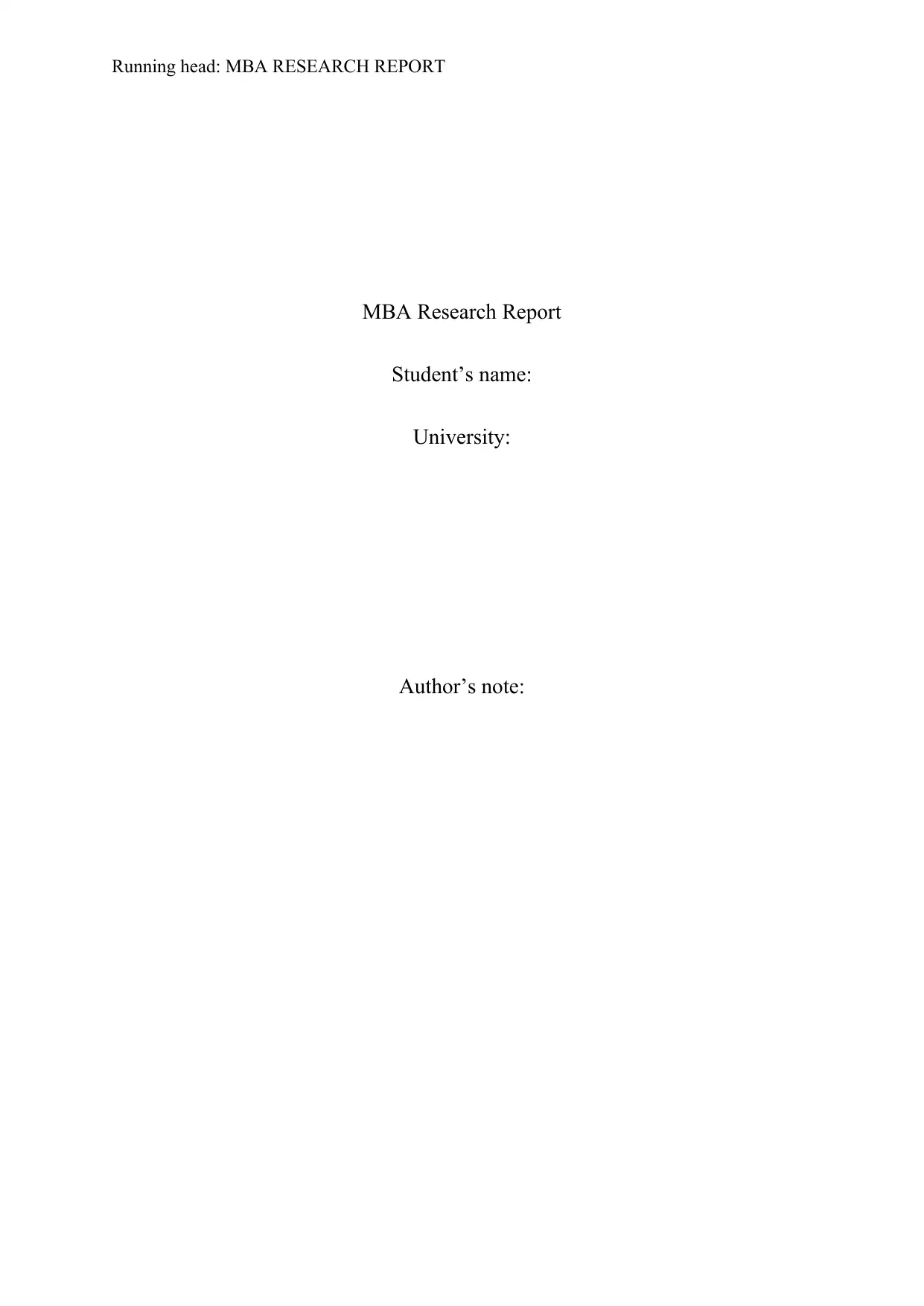
Running head: MBA RESEARCH REPORT
MBA Research Report
Student’s name:
University:
Author’s note:
MBA Research Report
Student’s name:
University:
Author’s note:
Paraphrase This Document
Need a fresh take? Get an instant paraphrase of this document with our AI Paraphraser
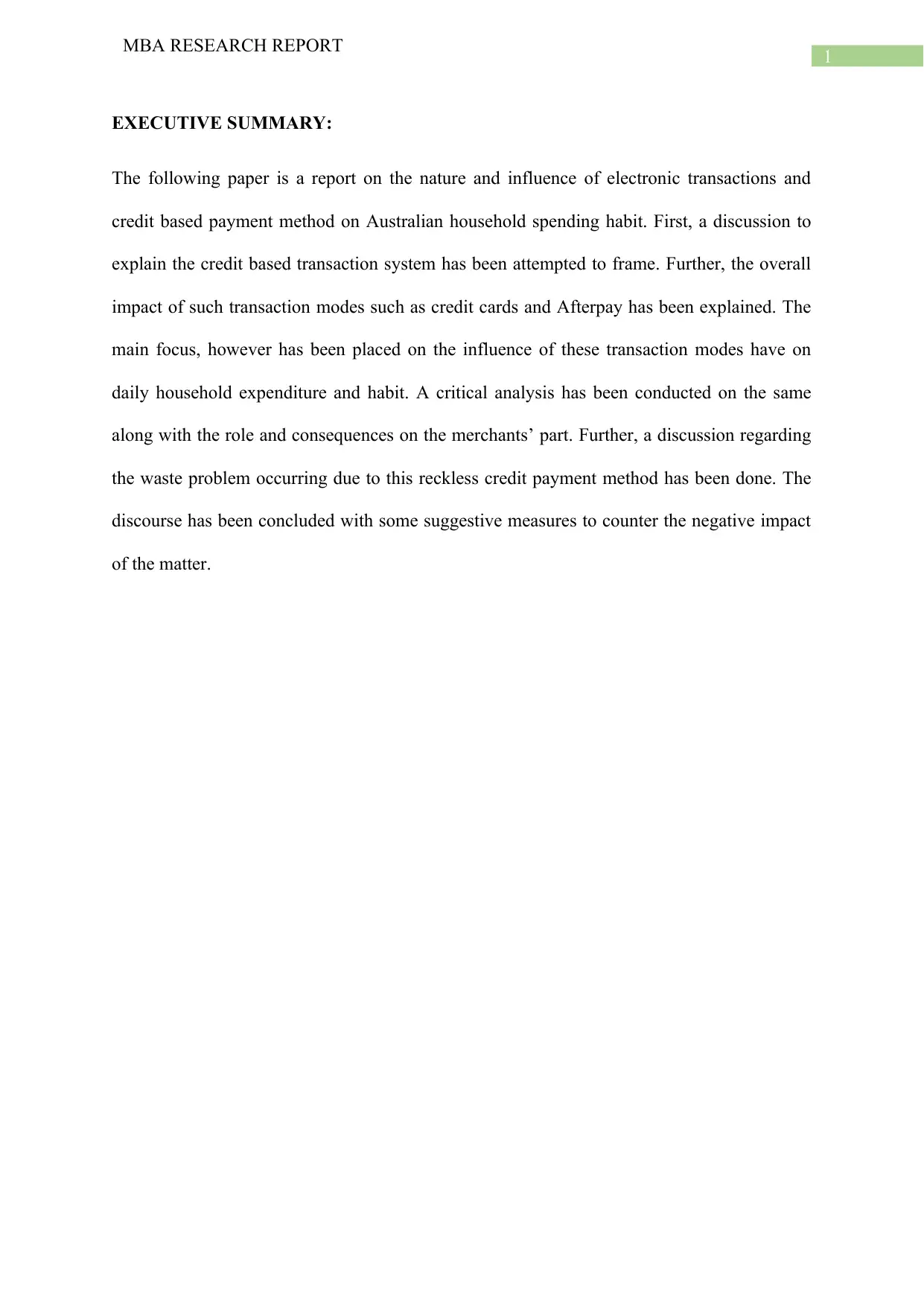
1
MBA RESEARCH REPORT
EXECUTIVE SUMMARY:
The following paper is a report on the nature and influence of electronic transactions and
credit based payment method on Australian household spending habit. First, a discussion to
explain the credit based transaction system has been attempted to frame. Further, the overall
impact of such transaction modes such as credit cards and Afterpay has been explained. The
main focus, however has been placed on the influence of these transaction modes have on
daily household expenditure and habit. A critical analysis has been conducted on the same
along with the role and consequences on the merchants’ part. Further, a discussion regarding
the waste problem occurring due to this reckless credit payment method has been done. The
discourse has been concluded with some suggestive measures to counter the negative impact
of the matter.
MBA RESEARCH REPORT
EXECUTIVE SUMMARY:
The following paper is a report on the nature and influence of electronic transactions and
credit based payment method on Australian household spending habit. First, a discussion to
explain the credit based transaction system has been attempted to frame. Further, the overall
impact of such transaction modes such as credit cards and Afterpay has been explained. The
main focus, however has been placed on the influence of these transaction modes have on
daily household expenditure and habit. A critical analysis has been conducted on the same
along with the role and consequences on the merchants’ part. Further, a discussion regarding
the waste problem occurring due to this reckless credit payment method has been done. The
discourse has been concluded with some suggestive measures to counter the negative impact
of the matter.
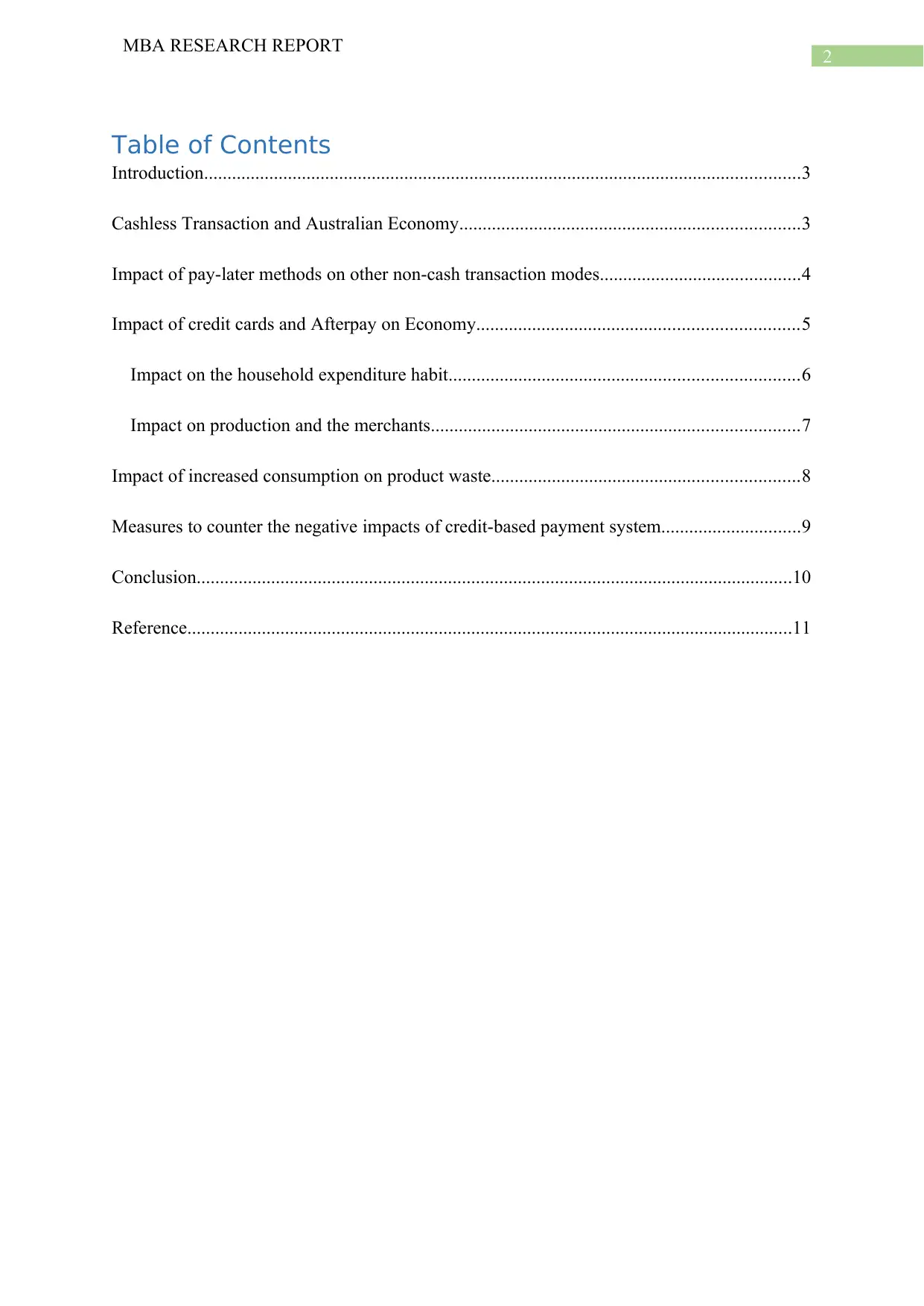
2
MBA RESEARCH REPORT
Table of Contents
Introduction................................................................................................................................3
Cashless Transaction and Australian Economy.........................................................................3
Impact of pay-later methods on other non-cash transaction modes...........................................4
Impact of credit cards and Afterpay on Economy.....................................................................5
Impact on the household expenditure habit...........................................................................6
Impact on production and the merchants...............................................................................7
Impact of increased consumption on product waste..................................................................8
Measures to counter the negative impacts of credit-based payment system..............................9
Conclusion................................................................................................................................10
Reference..................................................................................................................................11
MBA RESEARCH REPORT
Table of Contents
Introduction................................................................................................................................3
Cashless Transaction and Australian Economy.........................................................................3
Impact of pay-later methods on other non-cash transaction modes...........................................4
Impact of credit cards and Afterpay on Economy.....................................................................5
Impact on the household expenditure habit...........................................................................6
Impact on production and the merchants...............................................................................7
Impact of increased consumption on product waste..................................................................8
Measures to counter the negative impacts of credit-based payment system..............................9
Conclusion................................................................................................................................10
Reference..................................................................................................................................11
⊘ This is a preview!⊘
Do you want full access?
Subscribe today to unlock all pages.

Trusted by 1+ million students worldwide
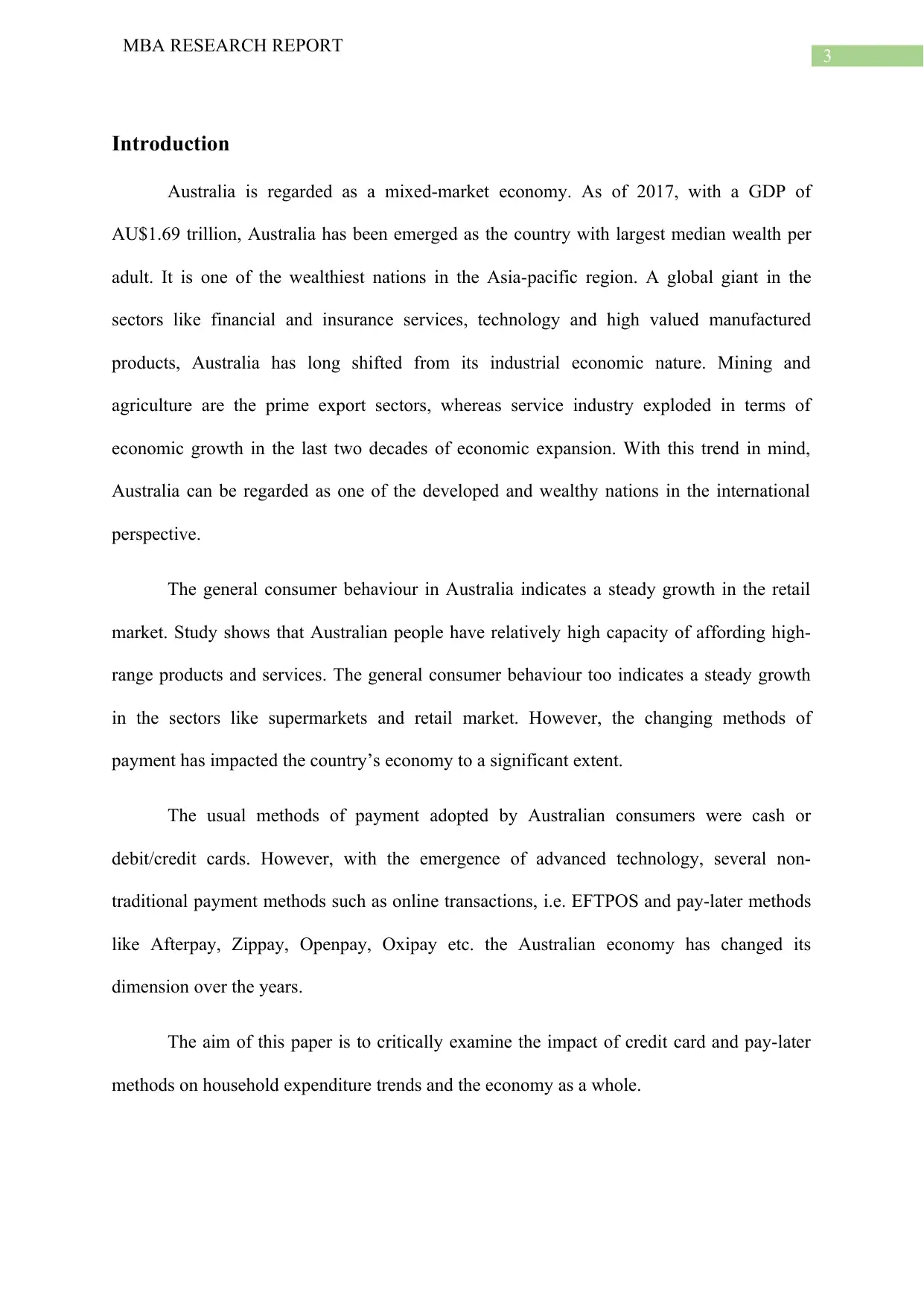
3
MBA RESEARCH REPORT
Introduction
Australia is regarded as a mixed-market economy. As of 2017, with a GDP of
AU$1.69 trillion, Australia has been emerged as the country with largest median wealth per
adult. It is one of the wealthiest nations in the Asia-pacific region. A global giant in the
sectors like financial and insurance services, technology and high valued manufactured
products, Australia has long shifted from its industrial economic nature. Mining and
agriculture are the prime export sectors, whereas service industry exploded in terms of
economic growth in the last two decades of economic expansion. With this trend in mind,
Australia can be regarded as one of the developed and wealthy nations in the international
perspective.
The general consumer behaviour in Australia indicates a steady growth in the retail
market. Study shows that Australian people have relatively high capacity of affording high-
range products and services. The general consumer behaviour too indicates a steady growth
in the sectors like supermarkets and retail market. However, the changing methods of
payment has impacted the country’s economy to a significant extent.
The usual methods of payment adopted by Australian consumers were cash or
debit/credit cards. However, with the emergence of advanced technology, several non-
traditional payment methods such as online transactions, i.e. EFTPOS and pay-later methods
like Afterpay, Zippay, Openpay, Oxipay etc. the Australian economy has changed its
dimension over the years.
The aim of this paper is to critically examine the impact of credit card and pay-later
methods on household expenditure trends and the economy as a whole.
MBA RESEARCH REPORT
Introduction
Australia is regarded as a mixed-market economy. As of 2017, with a GDP of
AU$1.69 trillion, Australia has been emerged as the country with largest median wealth per
adult. It is one of the wealthiest nations in the Asia-pacific region. A global giant in the
sectors like financial and insurance services, technology and high valued manufactured
products, Australia has long shifted from its industrial economic nature. Mining and
agriculture are the prime export sectors, whereas service industry exploded in terms of
economic growth in the last two decades of economic expansion. With this trend in mind,
Australia can be regarded as one of the developed and wealthy nations in the international
perspective.
The general consumer behaviour in Australia indicates a steady growth in the retail
market. Study shows that Australian people have relatively high capacity of affording high-
range products and services. The general consumer behaviour too indicates a steady growth
in the sectors like supermarkets and retail market. However, the changing methods of
payment has impacted the country’s economy to a significant extent.
The usual methods of payment adopted by Australian consumers were cash or
debit/credit cards. However, with the emergence of advanced technology, several non-
traditional payment methods such as online transactions, i.e. EFTPOS and pay-later methods
like Afterpay, Zippay, Openpay, Oxipay etc. the Australian economy has changed its
dimension over the years.
The aim of this paper is to critically examine the impact of credit card and pay-later
methods on household expenditure trends and the economy as a whole.
Paraphrase This Document
Need a fresh take? Get an instant paraphrase of this document with our AI Paraphraser
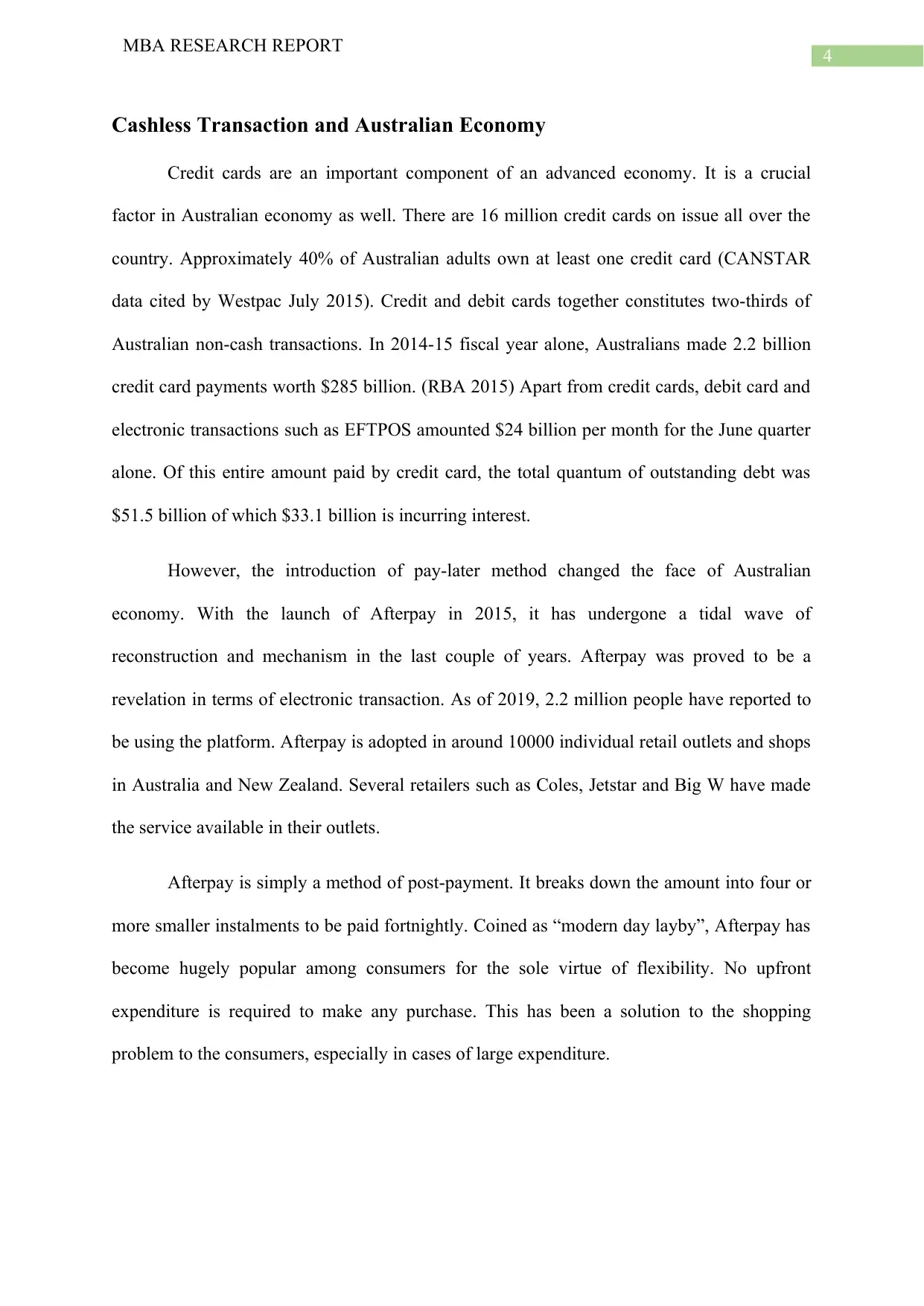
4
MBA RESEARCH REPORT
Cashless Transaction and Australian Economy
Credit cards are an important component of an advanced economy. It is a crucial
factor in Australian economy as well. There are 16 million credit cards on issue all over the
country. Approximately 40% of Australian adults own at least one credit card (CANSTAR
data cited by Westpac July 2015). Credit and debit cards together constitutes two-thirds of
Australian non-cash transactions. In 2014-15 fiscal year alone, Australians made 2.2 billion
credit card payments worth $285 billion. (RBA 2015) Apart from credit cards, debit card and
electronic transactions such as EFTPOS amounted $24 billion per month for the June quarter
alone. Of this entire amount paid by credit card, the total quantum of outstanding debt was
$51.5 billion of which $33.1 billion is incurring interest.
However, the introduction of pay-later method changed the face of Australian
economy. With the launch of Afterpay in 2015, it has undergone a tidal wave of
reconstruction and mechanism in the last couple of years. Afterpay was proved to be a
revelation in terms of electronic transaction. As of 2019, 2.2 million people have reported to
be using the platform. Afterpay is adopted in around 10000 individual retail outlets and shops
in Australia and New Zealand. Several retailers such as Coles, Jetstar and Big W have made
the service available in their outlets.
Afterpay is simply a method of post-payment. It breaks down the amount into four or
more smaller instalments to be paid fortnightly. Coined as “modern day layby”, Afterpay has
become hugely popular among consumers for the sole virtue of flexibility. No upfront
expenditure is required to make any purchase. This has been a solution to the shopping
problem to the consumers, especially in cases of large expenditure.
MBA RESEARCH REPORT
Cashless Transaction and Australian Economy
Credit cards are an important component of an advanced economy. It is a crucial
factor in Australian economy as well. There are 16 million credit cards on issue all over the
country. Approximately 40% of Australian adults own at least one credit card (CANSTAR
data cited by Westpac July 2015). Credit and debit cards together constitutes two-thirds of
Australian non-cash transactions. In 2014-15 fiscal year alone, Australians made 2.2 billion
credit card payments worth $285 billion. (RBA 2015) Apart from credit cards, debit card and
electronic transactions such as EFTPOS amounted $24 billion per month for the June quarter
alone. Of this entire amount paid by credit card, the total quantum of outstanding debt was
$51.5 billion of which $33.1 billion is incurring interest.
However, the introduction of pay-later method changed the face of Australian
economy. With the launch of Afterpay in 2015, it has undergone a tidal wave of
reconstruction and mechanism in the last couple of years. Afterpay was proved to be a
revelation in terms of electronic transaction. As of 2019, 2.2 million people have reported to
be using the platform. Afterpay is adopted in around 10000 individual retail outlets and shops
in Australia and New Zealand. Several retailers such as Coles, Jetstar and Big W have made
the service available in their outlets.
Afterpay is simply a method of post-payment. It breaks down the amount into four or
more smaller instalments to be paid fortnightly. Coined as “modern day layby”, Afterpay has
become hugely popular among consumers for the sole virtue of flexibility. No upfront
expenditure is required to make any purchase. This has been a solution to the shopping
problem to the consumers, especially in cases of large expenditure.
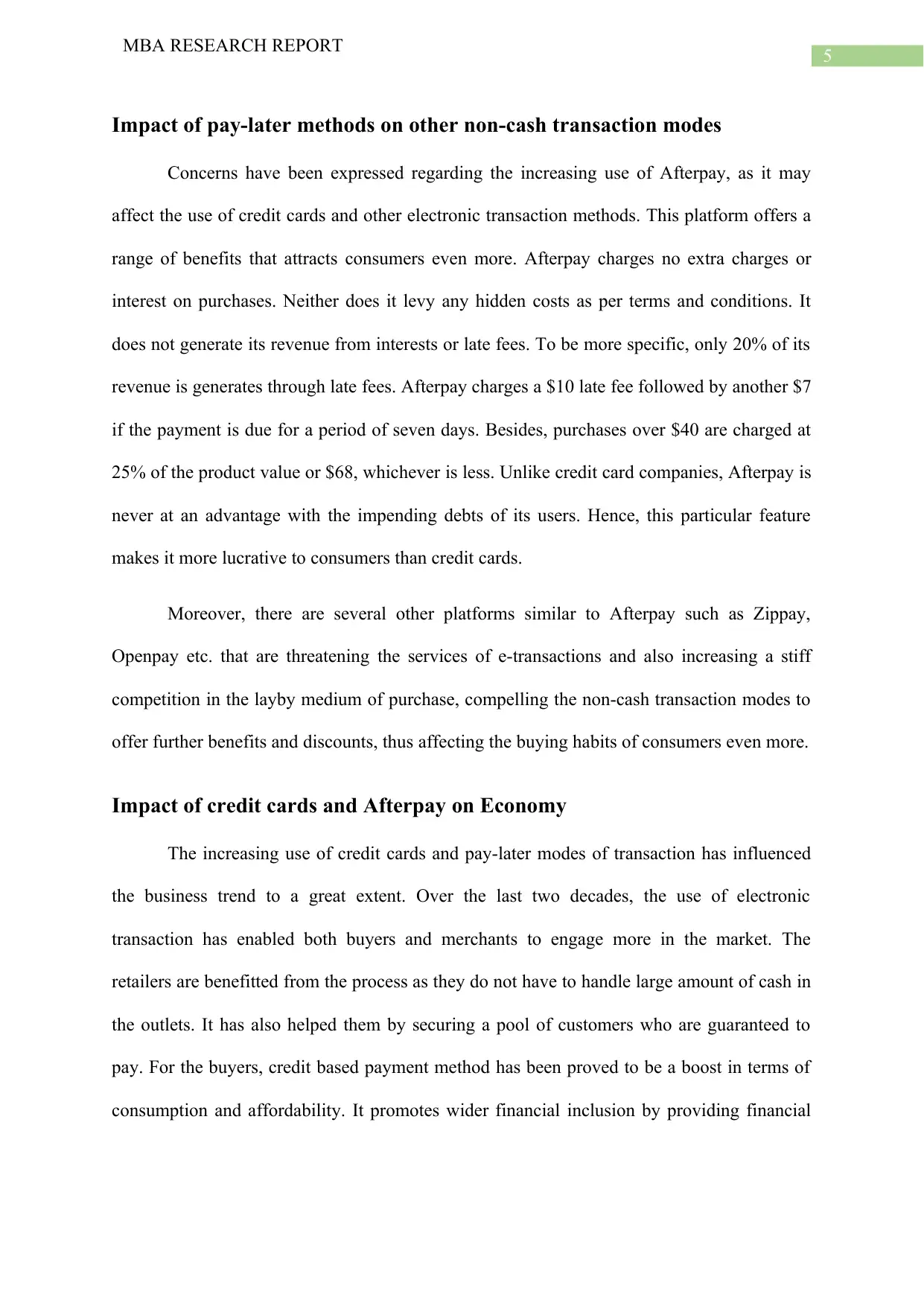
5
MBA RESEARCH REPORT
Impact of pay-later methods on other non-cash transaction modes
Concerns have been expressed regarding the increasing use of Afterpay, as it may
affect the use of credit cards and other electronic transaction methods. This platform offers a
range of benefits that attracts consumers even more. Afterpay charges no extra charges or
interest on purchases. Neither does it levy any hidden costs as per terms and conditions. It
does not generate its revenue from interests or late fees. To be more specific, only 20% of its
revenue is generates through late fees. Afterpay charges a $10 late fee followed by another $7
if the payment is due for a period of seven days. Besides, purchases over $40 are charged at
25% of the product value or $68, whichever is less. Unlike credit card companies, Afterpay is
never at an advantage with the impending debts of its users. Hence, this particular feature
makes it more lucrative to consumers than credit cards.
Moreover, there are several other platforms similar to Afterpay such as Zippay,
Openpay etc. that are threatening the services of e-transactions and also increasing a stiff
competition in the layby medium of purchase, compelling the non-cash transaction modes to
offer further benefits and discounts, thus affecting the buying habits of consumers even more.
Impact of credit cards and Afterpay on Economy
The increasing use of credit cards and pay-later modes of transaction has influenced
the business trend to a great extent. Over the last two decades, the use of electronic
transaction has enabled both buyers and merchants to engage more in the market. The
retailers are benefitted from the process as they do not have to handle large amount of cash in
the outlets. It has also helped them by securing a pool of customers who are guaranteed to
pay. For the buyers, credit based payment method has been proved to be a boost in terms of
consumption and affordability. It promotes wider financial inclusion by providing financial
MBA RESEARCH REPORT
Impact of pay-later methods on other non-cash transaction modes
Concerns have been expressed regarding the increasing use of Afterpay, as it may
affect the use of credit cards and other electronic transaction methods. This platform offers a
range of benefits that attracts consumers even more. Afterpay charges no extra charges or
interest on purchases. Neither does it levy any hidden costs as per terms and conditions. It
does not generate its revenue from interests or late fees. To be more specific, only 20% of its
revenue is generates through late fees. Afterpay charges a $10 late fee followed by another $7
if the payment is due for a period of seven days. Besides, purchases over $40 are charged at
25% of the product value or $68, whichever is less. Unlike credit card companies, Afterpay is
never at an advantage with the impending debts of its users. Hence, this particular feature
makes it more lucrative to consumers than credit cards.
Moreover, there are several other platforms similar to Afterpay such as Zippay,
Openpay etc. that are threatening the services of e-transactions and also increasing a stiff
competition in the layby medium of purchase, compelling the non-cash transaction modes to
offer further benefits and discounts, thus affecting the buying habits of consumers even more.
Impact of credit cards and Afterpay on Economy
The increasing use of credit cards and pay-later modes of transaction has influenced
the business trend to a great extent. Over the last two decades, the use of electronic
transaction has enabled both buyers and merchants to engage more in the market. The
retailers are benefitted from the process as they do not have to handle large amount of cash in
the outlets. It has also helped them by securing a pool of customers who are guaranteed to
pay. For the buyers, credit based payment method has been proved to be a boost in terms of
consumption and affordability. It promotes wider financial inclusion by providing financial
⊘ This is a preview!⊘
Do you want full access?
Subscribe today to unlock all pages.

Trusted by 1+ million students worldwide
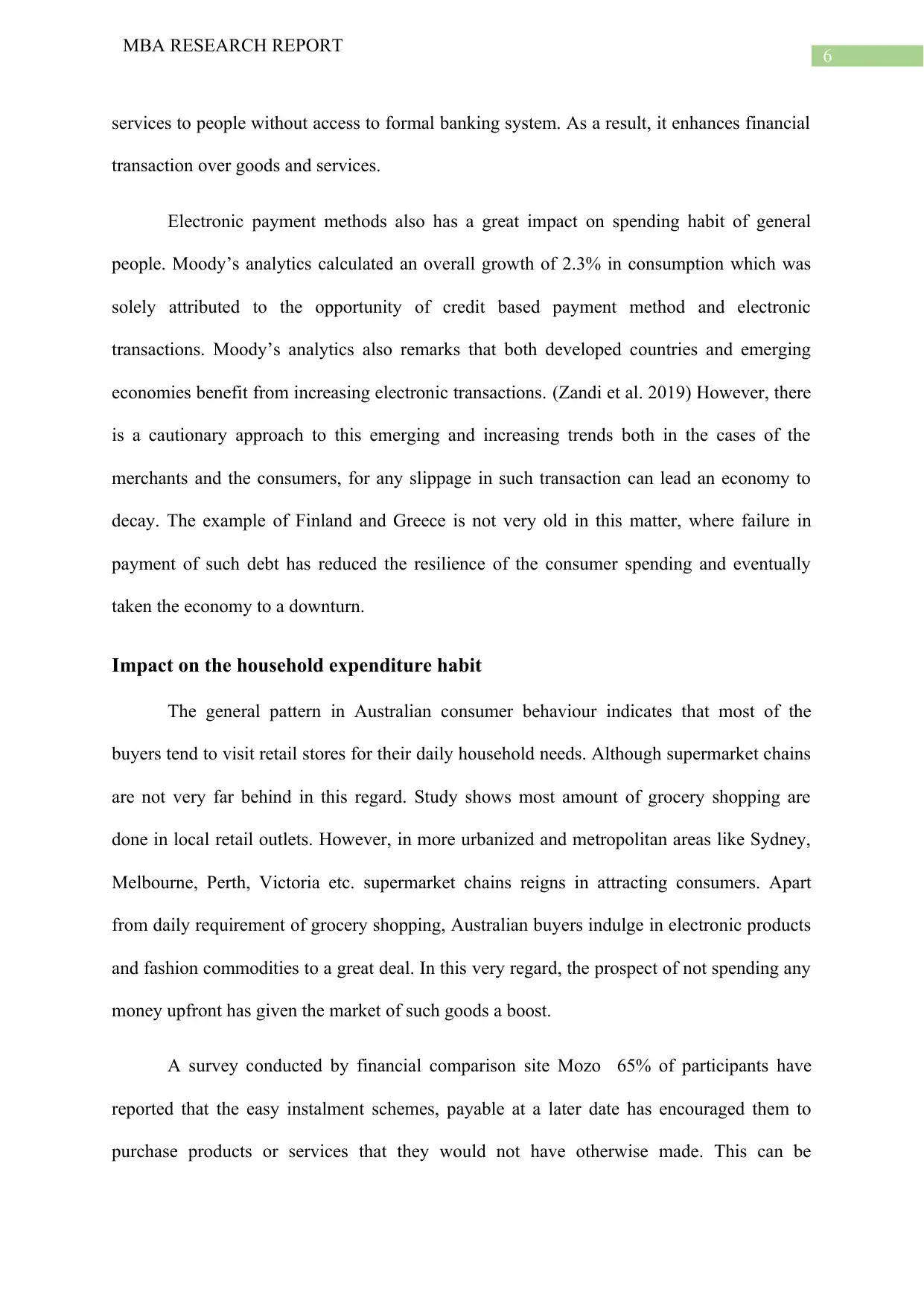
6
MBA RESEARCH REPORT
services to people without access to formal banking system. As a result, it enhances financial
transaction over goods and services.
Electronic payment methods also has a great impact on spending habit of general
people. Moody’s analytics calculated an overall growth of 2.3% in consumption which was
solely attributed to the opportunity of credit based payment method and electronic
transactions. Moody’s analytics also remarks that both developed countries and emerging
economies benefit from increasing electronic transactions. (Zandi et al. 2019) However, there
is a cautionary approach to this emerging and increasing trends both in the cases of the
merchants and the consumers, for any slippage in such transaction can lead an economy to
decay. The example of Finland and Greece is not very old in this matter, where failure in
payment of such debt has reduced the resilience of the consumer spending and eventually
taken the economy to a downturn.
Impact on the household expenditure habit
The general pattern in Australian consumer behaviour indicates that most of the
buyers tend to visit retail stores for their daily household needs. Although supermarket chains
are not very far behind in this regard. Study shows most amount of grocery shopping are
done in local retail outlets. However, in more urbanized and metropolitan areas like Sydney,
Melbourne, Perth, Victoria etc. supermarket chains reigns in attracting consumers. Apart
from daily requirement of grocery shopping, Australian buyers indulge in electronic products
and fashion commodities to a great deal. In this very regard, the prospect of not spending any
money upfront has given the market of such goods a boost.
A survey conducted by financial comparison site Mozo 65% of participants have
reported that the easy instalment schemes, payable at a later date has encouraged them to
purchase products or services that they would not have otherwise made. This can be
MBA RESEARCH REPORT
services to people without access to formal banking system. As a result, it enhances financial
transaction over goods and services.
Electronic payment methods also has a great impact on spending habit of general
people. Moody’s analytics calculated an overall growth of 2.3% in consumption which was
solely attributed to the opportunity of credit based payment method and electronic
transactions. Moody’s analytics also remarks that both developed countries and emerging
economies benefit from increasing electronic transactions. (Zandi et al. 2019) However, there
is a cautionary approach to this emerging and increasing trends both in the cases of the
merchants and the consumers, for any slippage in such transaction can lead an economy to
decay. The example of Finland and Greece is not very old in this matter, where failure in
payment of such debt has reduced the resilience of the consumer spending and eventually
taken the economy to a downturn.
Impact on the household expenditure habit
The general pattern in Australian consumer behaviour indicates that most of the
buyers tend to visit retail stores for their daily household needs. Although supermarket chains
are not very far behind in this regard. Study shows most amount of grocery shopping are
done in local retail outlets. However, in more urbanized and metropolitan areas like Sydney,
Melbourne, Perth, Victoria etc. supermarket chains reigns in attracting consumers. Apart
from daily requirement of grocery shopping, Australian buyers indulge in electronic products
and fashion commodities to a great deal. In this very regard, the prospect of not spending any
money upfront has given the market of such goods a boost.
A survey conducted by financial comparison site Mozo 65% of participants have
reported that the easy instalment schemes, payable at a later date has encouraged them to
purchase products or services that they would not have otherwise made. This can be
Paraphrase This Document
Need a fresh take? Get an instant paraphrase of this document with our AI Paraphraser
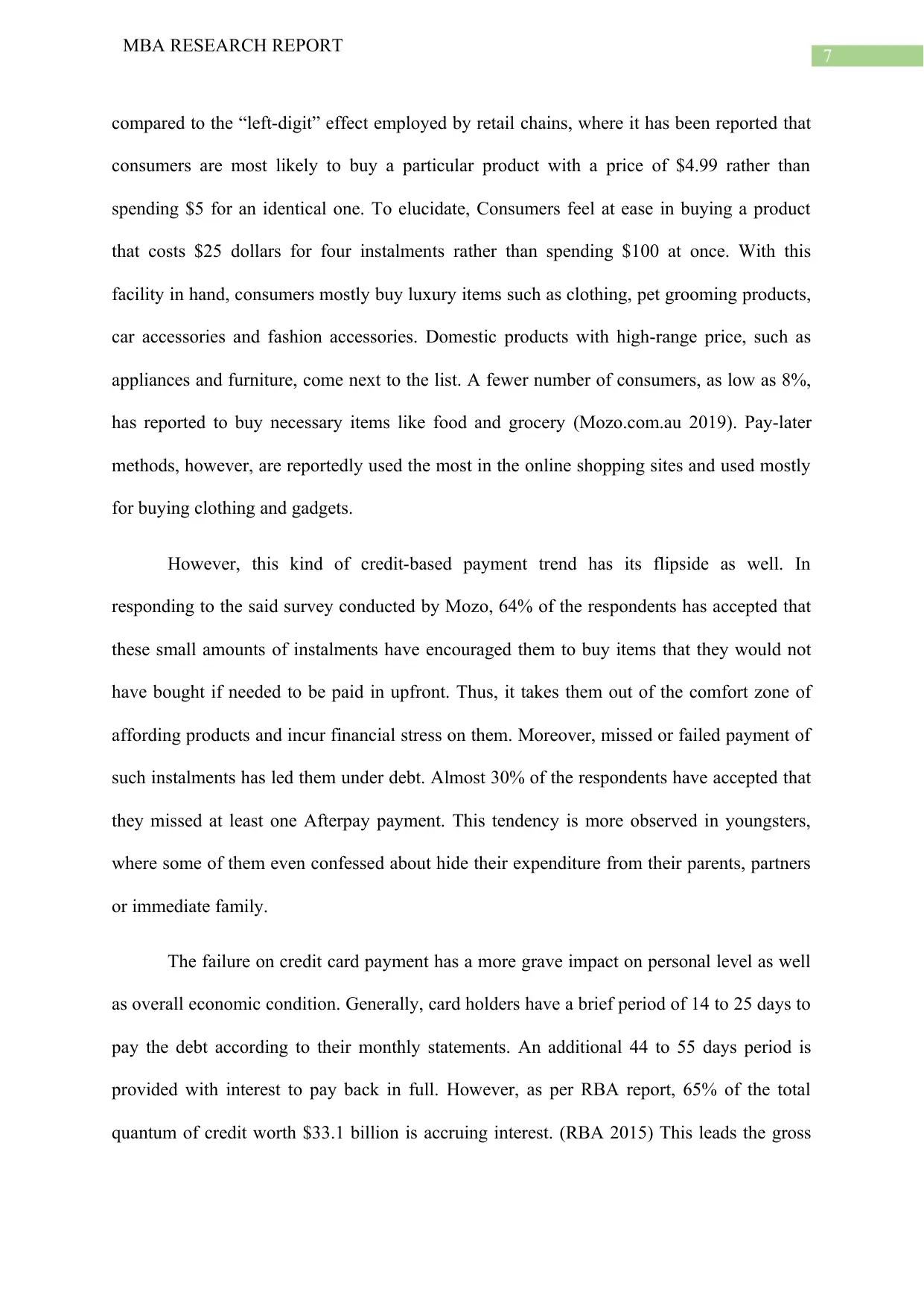
7
MBA RESEARCH REPORT
compared to the “left-digit” effect employed by retail chains, where it has been reported that
consumers are most likely to buy a particular product with a price of $4.99 rather than
spending $5 for an identical one. To elucidate, Consumers feel at ease in buying a product
that costs $25 dollars for four instalments rather than spending $100 at once. With this
facility in hand, consumers mostly buy luxury items such as clothing, pet grooming products,
car accessories and fashion accessories. Domestic products with high-range price, such as
appliances and furniture, come next to the list. A fewer number of consumers, as low as 8%,
has reported to buy necessary items like food and grocery (Mozo.com.au 2019). Pay-later
methods, however, are reportedly used the most in the online shopping sites and used mostly
for buying clothing and gadgets.
However, this kind of credit-based payment trend has its flipside as well. In
responding to the said survey conducted by Mozo, 64% of the respondents has accepted that
these small amounts of instalments have encouraged them to buy items that they would not
have bought if needed to be paid in upfront. Thus, it takes them out of the comfort zone of
affording products and incur financial stress on them. Moreover, missed or failed payment of
such instalments has led them under debt. Almost 30% of the respondents have accepted that
they missed at least one Afterpay payment. This tendency is more observed in youngsters,
where some of them even confessed about hide their expenditure from their parents, partners
or immediate family.
The failure on credit card payment has a more grave impact on personal level as well
as overall economic condition. Generally, card holders have a brief period of 14 to 25 days to
pay the debt according to their monthly statements. An additional 44 to 55 days period is
provided with interest to pay back in full. However, as per RBA report, 65% of the total
quantum of credit worth $33.1 billion is accruing interest. (RBA 2015) This leads the gross
MBA RESEARCH REPORT
compared to the “left-digit” effect employed by retail chains, where it has been reported that
consumers are most likely to buy a particular product with a price of $4.99 rather than
spending $5 for an identical one. To elucidate, Consumers feel at ease in buying a product
that costs $25 dollars for four instalments rather than spending $100 at once. With this
facility in hand, consumers mostly buy luxury items such as clothing, pet grooming products,
car accessories and fashion accessories. Domestic products with high-range price, such as
appliances and furniture, come next to the list. A fewer number of consumers, as low as 8%,
has reported to buy necessary items like food and grocery (Mozo.com.au 2019). Pay-later
methods, however, are reportedly used the most in the online shopping sites and used mostly
for buying clothing and gadgets.
However, this kind of credit-based payment trend has its flipside as well. In
responding to the said survey conducted by Mozo, 64% of the respondents has accepted that
these small amounts of instalments have encouraged them to buy items that they would not
have bought if needed to be paid in upfront. Thus, it takes them out of the comfort zone of
affording products and incur financial stress on them. Moreover, missed or failed payment of
such instalments has led them under debt. Almost 30% of the respondents have accepted that
they missed at least one Afterpay payment. This tendency is more observed in youngsters,
where some of them even confessed about hide their expenditure from their parents, partners
or immediate family.
The failure on credit card payment has a more grave impact on personal level as well
as overall economic condition. Generally, card holders have a brief period of 14 to 25 days to
pay the debt according to their monthly statements. An additional 44 to 55 days period is
provided with interest to pay back in full. However, as per RBA report, 65% of the total
quantum of credit worth $33.1 billion is accruing interest. (RBA 2015) This leads the gross
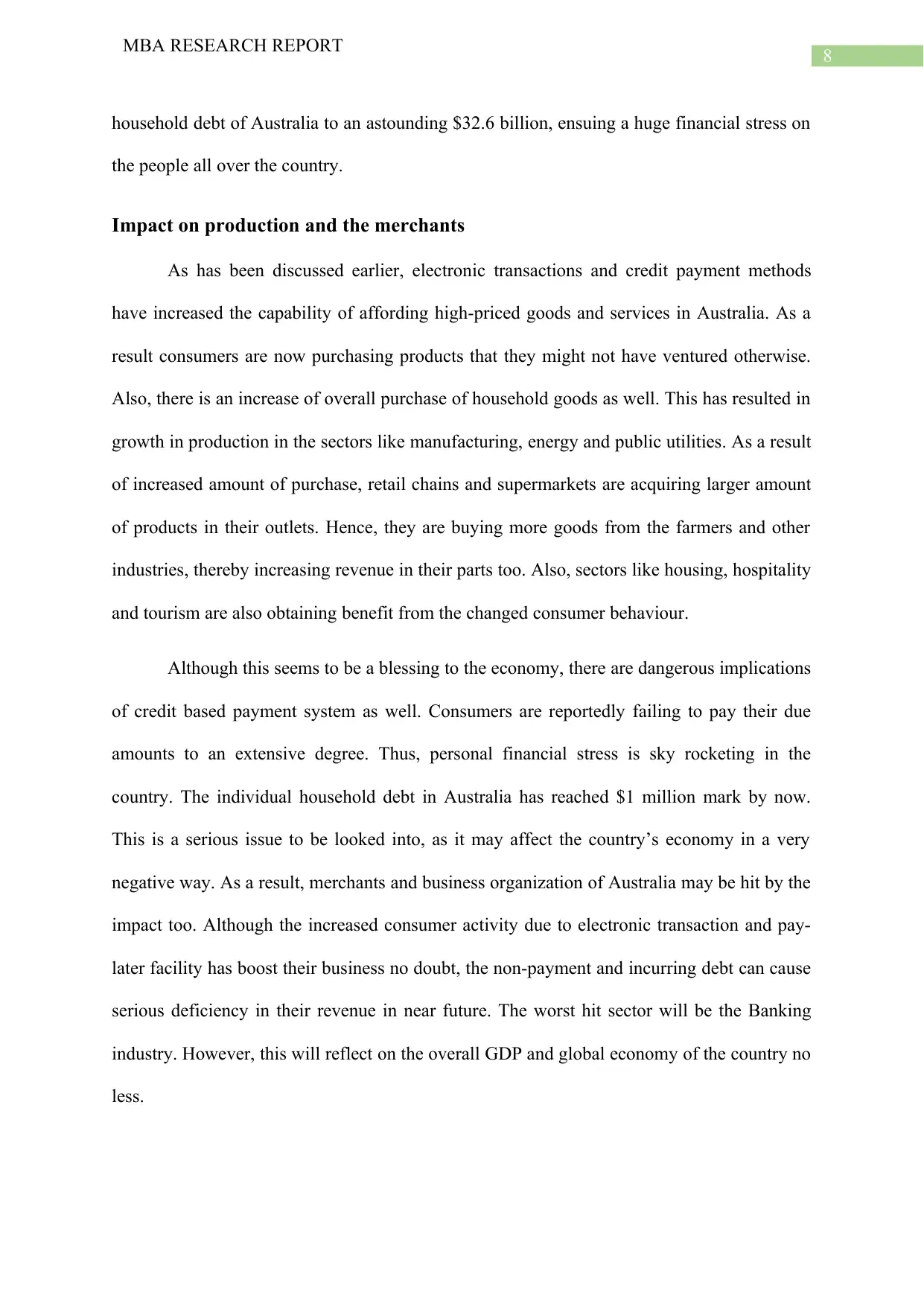
8
MBA RESEARCH REPORT
household debt of Australia to an astounding $32.6 billion, ensuing a huge financial stress on
the people all over the country.
Impact on production and the merchants
As has been discussed earlier, electronic transactions and credit payment methods
have increased the capability of affording high-priced goods and services in Australia. As a
result consumers are now purchasing products that they might not have ventured otherwise.
Also, there is an increase of overall purchase of household goods as well. This has resulted in
growth in production in the sectors like manufacturing, energy and public utilities. As a result
of increased amount of purchase, retail chains and supermarkets are acquiring larger amount
of products in their outlets. Hence, they are buying more goods from the farmers and other
industries, thereby increasing revenue in their parts too. Also, sectors like housing, hospitality
and tourism are also obtaining benefit from the changed consumer behaviour.
Although this seems to be a blessing to the economy, there are dangerous implications
of credit based payment system as well. Consumers are reportedly failing to pay their due
amounts to an extensive degree. Thus, personal financial stress is sky rocketing in the
country. The individual household debt in Australia has reached $1 million mark by now.
This is a serious issue to be looked into, as it may affect the country’s economy in a very
negative way. As a result, merchants and business organization of Australia may be hit by the
impact too. Although the increased consumer activity due to electronic transaction and pay-
later facility has boost their business no doubt, the non-payment and incurring debt can cause
serious deficiency in their revenue in near future. The worst hit sector will be the Banking
industry. However, this will reflect on the overall GDP and global economy of the country no
less.
MBA RESEARCH REPORT
household debt of Australia to an astounding $32.6 billion, ensuing a huge financial stress on
the people all over the country.
Impact on production and the merchants
As has been discussed earlier, electronic transactions and credit payment methods
have increased the capability of affording high-priced goods and services in Australia. As a
result consumers are now purchasing products that they might not have ventured otherwise.
Also, there is an increase of overall purchase of household goods as well. This has resulted in
growth in production in the sectors like manufacturing, energy and public utilities. As a result
of increased amount of purchase, retail chains and supermarkets are acquiring larger amount
of products in their outlets. Hence, they are buying more goods from the farmers and other
industries, thereby increasing revenue in their parts too. Also, sectors like housing, hospitality
and tourism are also obtaining benefit from the changed consumer behaviour.
Although this seems to be a blessing to the economy, there are dangerous implications
of credit based payment system as well. Consumers are reportedly failing to pay their due
amounts to an extensive degree. Thus, personal financial stress is sky rocketing in the
country. The individual household debt in Australia has reached $1 million mark by now.
This is a serious issue to be looked into, as it may affect the country’s economy in a very
negative way. As a result, merchants and business organization of Australia may be hit by the
impact too. Although the increased consumer activity due to electronic transaction and pay-
later facility has boost their business no doubt, the non-payment and incurring debt can cause
serious deficiency in their revenue in near future. The worst hit sector will be the Banking
industry. However, this will reflect on the overall GDP and global economy of the country no
less.
⊘ This is a preview!⊘
Do you want full access?
Subscribe today to unlock all pages.

Trusted by 1+ million students worldwide
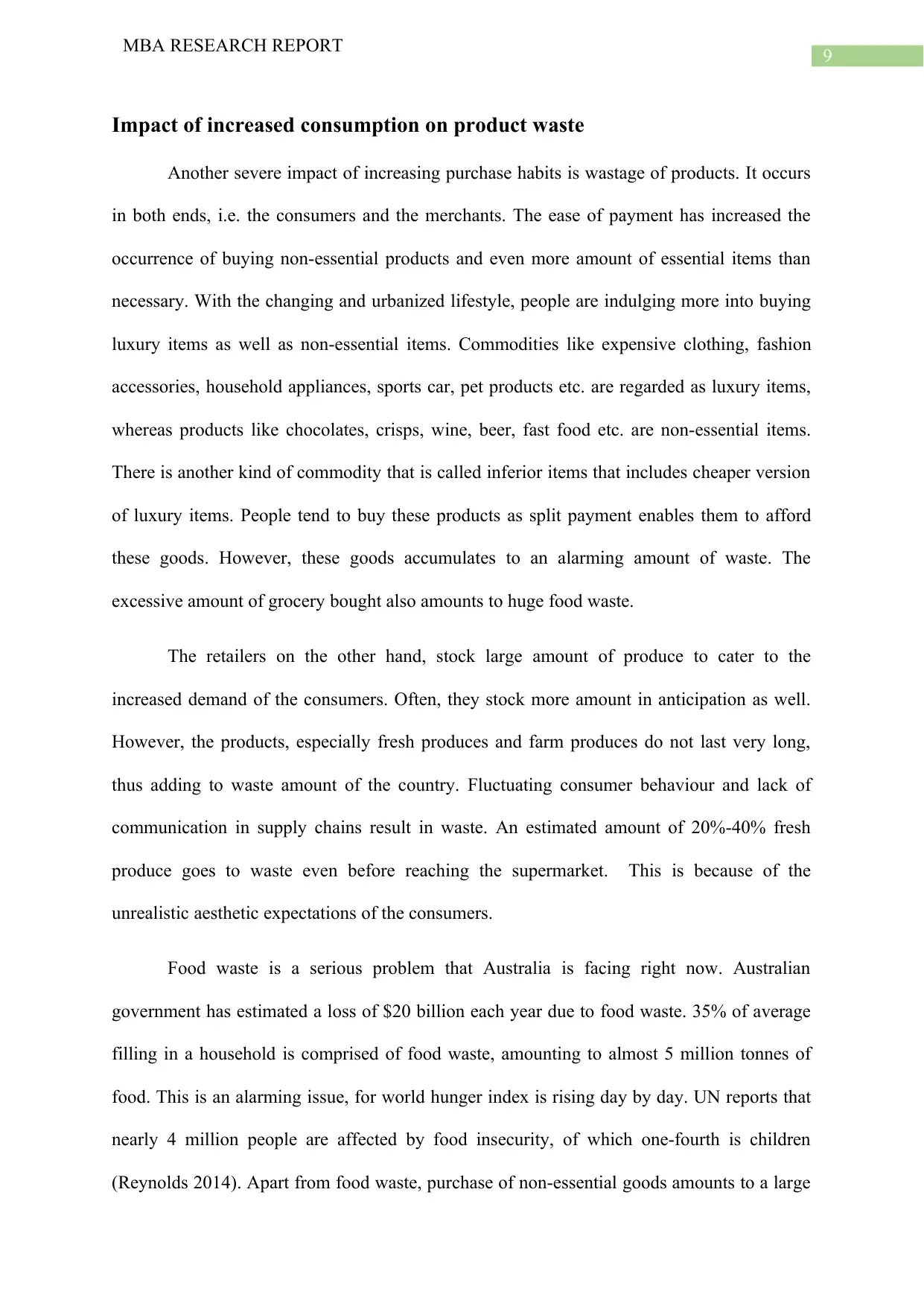
9
MBA RESEARCH REPORT
Impact of increased consumption on product waste
Another severe impact of increasing purchase habits is wastage of products. It occurs
in both ends, i.e. the consumers and the merchants. The ease of payment has increased the
occurrence of buying non-essential products and even more amount of essential items than
necessary. With the changing and urbanized lifestyle, people are indulging more into buying
luxury items as well as non-essential items. Commodities like expensive clothing, fashion
accessories, household appliances, sports car, pet products etc. are regarded as luxury items,
whereas products like chocolates, crisps, wine, beer, fast food etc. are non-essential items.
There is another kind of commodity that is called inferior items that includes cheaper version
of luxury items. People tend to buy these products as split payment enables them to afford
these goods. However, these goods accumulates to an alarming amount of waste. The
excessive amount of grocery bought also amounts to huge food waste.
The retailers on the other hand, stock large amount of produce to cater to the
increased demand of the consumers. Often, they stock more amount in anticipation as well.
However, the products, especially fresh produces and farm produces do not last very long,
thus adding to waste amount of the country. Fluctuating consumer behaviour and lack of
communication in supply chains result in waste. An estimated amount of 20%-40% fresh
produce goes to waste even before reaching the supermarket. This is because of the
unrealistic aesthetic expectations of the consumers.
Food waste is a serious problem that Australia is facing right now. Australian
government has estimated a loss of $20 billion each year due to food waste. 35% of average
filling in a household is comprised of food waste, amounting to almost 5 million tonnes of
food. This is an alarming issue, for world hunger index is rising day by day. UN reports that
nearly 4 million people are affected by food insecurity, of which one-fourth is children
(Reynolds 2014). Apart from food waste, purchase of non-essential goods amounts to a large
MBA RESEARCH REPORT
Impact of increased consumption on product waste
Another severe impact of increasing purchase habits is wastage of products. It occurs
in both ends, i.e. the consumers and the merchants. The ease of payment has increased the
occurrence of buying non-essential products and even more amount of essential items than
necessary. With the changing and urbanized lifestyle, people are indulging more into buying
luxury items as well as non-essential items. Commodities like expensive clothing, fashion
accessories, household appliances, sports car, pet products etc. are regarded as luxury items,
whereas products like chocolates, crisps, wine, beer, fast food etc. are non-essential items.
There is another kind of commodity that is called inferior items that includes cheaper version
of luxury items. People tend to buy these products as split payment enables them to afford
these goods. However, these goods accumulates to an alarming amount of waste. The
excessive amount of grocery bought also amounts to huge food waste.
The retailers on the other hand, stock large amount of produce to cater to the
increased demand of the consumers. Often, they stock more amount in anticipation as well.
However, the products, especially fresh produces and farm produces do not last very long,
thus adding to waste amount of the country. Fluctuating consumer behaviour and lack of
communication in supply chains result in waste. An estimated amount of 20%-40% fresh
produce goes to waste even before reaching the supermarket. This is because of the
unrealistic aesthetic expectations of the consumers.
Food waste is a serious problem that Australia is facing right now. Australian
government has estimated a loss of $20 billion each year due to food waste. 35% of average
filling in a household is comprised of food waste, amounting to almost 5 million tonnes of
food. This is an alarming issue, for world hunger index is rising day by day. UN reports that
nearly 4 million people are affected by food insecurity, of which one-fourth is children
(Reynolds 2014). Apart from food waste, purchase of non-essential goods amounts to a large
Paraphrase This Document
Need a fresh take? Get an instant paraphrase of this document with our AI Paraphraser
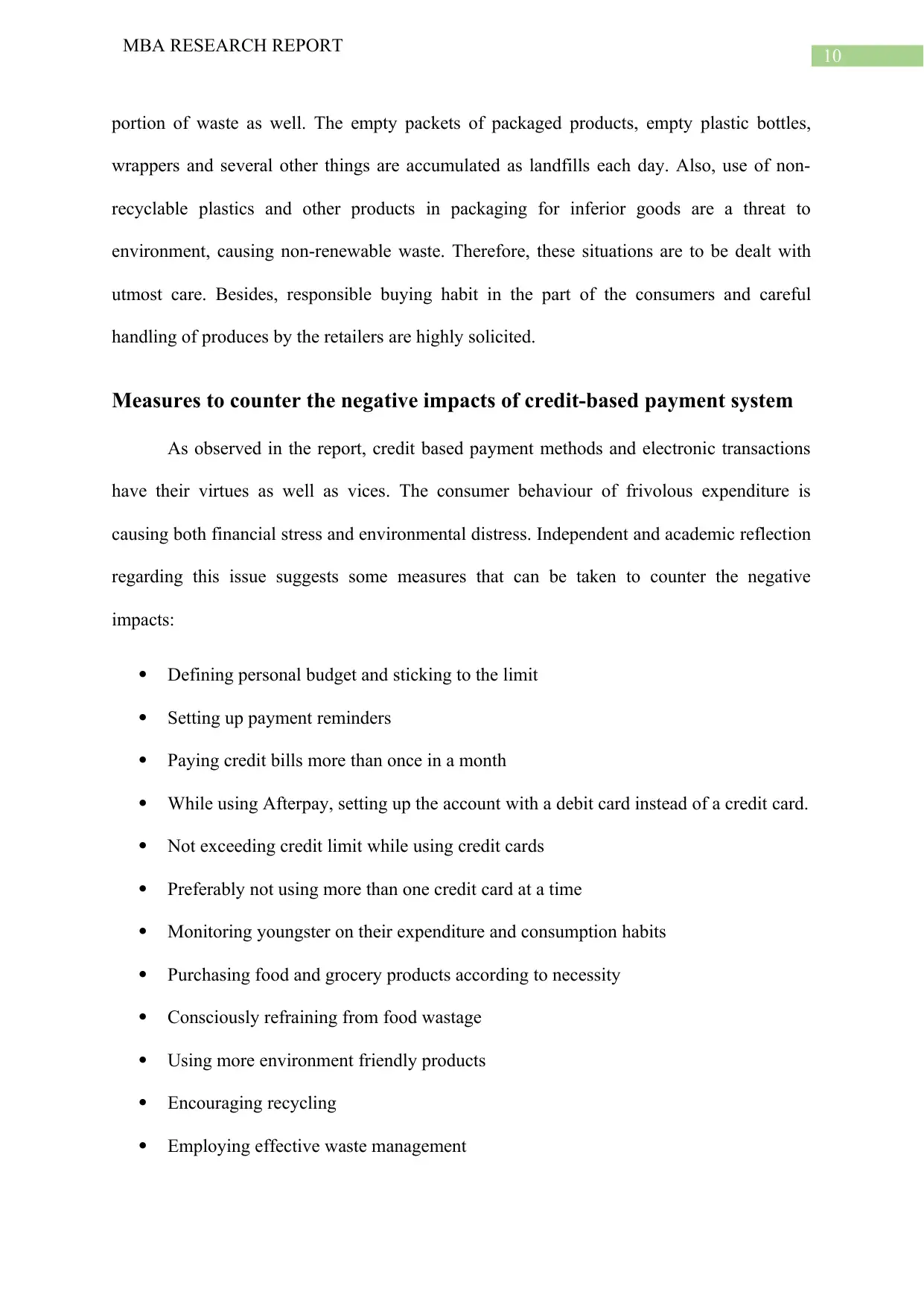
10
MBA RESEARCH REPORT
portion of waste as well. The empty packets of packaged products, empty plastic bottles,
wrappers and several other things are accumulated as landfills each day. Also, use of non-
recyclable plastics and other products in packaging for inferior goods are a threat to
environment, causing non-renewable waste. Therefore, these situations are to be dealt with
utmost care. Besides, responsible buying habit in the part of the consumers and careful
handling of produces by the retailers are highly solicited.
Measures to counter the negative impacts of credit-based payment system
As observed in the report, credit based payment methods and electronic transactions
have their virtues as well as vices. The consumer behaviour of frivolous expenditure is
causing both financial stress and environmental distress. Independent and academic reflection
regarding this issue suggests some measures that can be taken to counter the negative
impacts:
Defining personal budget and sticking to the limit
Setting up payment reminders
Paying credit bills more than once in a month
While using Afterpay, setting up the account with a debit card instead of a credit card.
Not exceeding credit limit while using credit cards
Preferably not using more than one credit card at a time
Monitoring youngster on their expenditure and consumption habits
Purchasing food and grocery products according to necessity
Consciously refraining from food wastage
Using more environment friendly products
Encouraging recycling
Employing effective waste management
MBA RESEARCH REPORT
portion of waste as well. The empty packets of packaged products, empty plastic bottles,
wrappers and several other things are accumulated as landfills each day. Also, use of non-
recyclable plastics and other products in packaging for inferior goods are a threat to
environment, causing non-renewable waste. Therefore, these situations are to be dealt with
utmost care. Besides, responsible buying habit in the part of the consumers and careful
handling of produces by the retailers are highly solicited.
Measures to counter the negative impacts of credit-based payment system
As observed in the report, credit based payment methods and electronic transactions
have their virtues as well as vices. The consumer behaviour of frivolous expenditure is
causing both financial stress and environmental distress. Independent and academic reflection
regarding this issue suggests some measures that can be taken to counter the negative
impacts:
Defining personal budget and sticking to the limit
Setting up payment reminders
Paying credit bills more than once in a month
While using Afterpay, setting up the account with a debit card instead of a credit card.
Not exceeding credit limit while using credit cards
Preferably not using more than one credit card at a time
Monitoring youngster on their expenditure and consumption habits
Purchasing food and grocery products according to necessity
Consciously refraining from food wastage
Using more environment friendly products
Encouraging recycling
Employing effective waste management
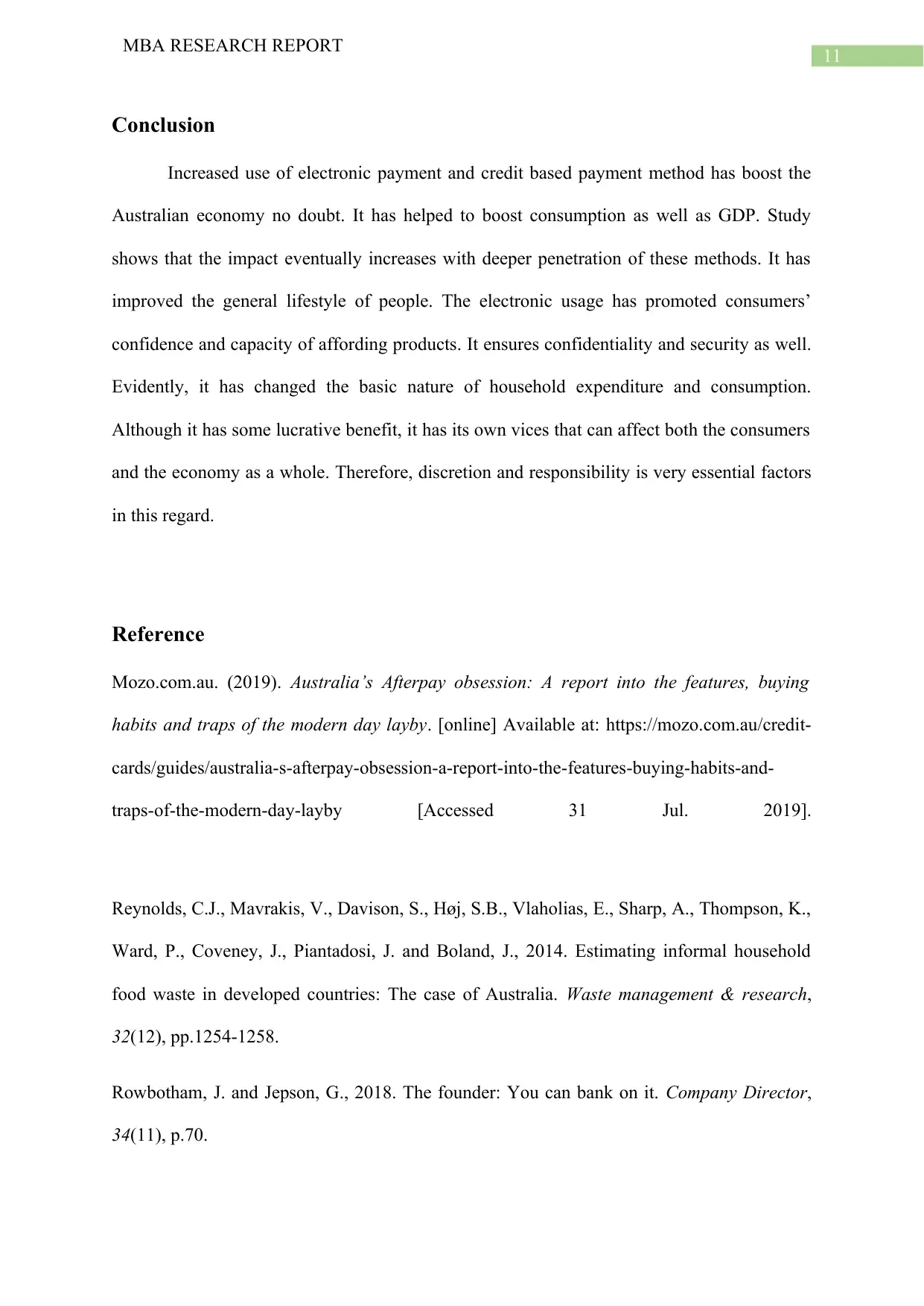
11
MBA RESEARCH REPORT
Conclusion
Increased use of electronic payment and credit based payment method has boost the
Australian economy no doubt. It has helped to boost consumption as well as GDP. Study
shows that the impact eventually increases with deeper penetration of these methods. It has
improved the general lifestyle of people. The electronic usage has promoted consumers’
confidence and capacity of affording products. It ensures confidentiality and security as well.
Evidently, it has changed the basic nature of household expenditure and consumption.
Although it has some lucrative benefit, it has its own vices that can affect both the consumers
and the economy as a whole. Therefore, discretion and responsibility is very essential factors
in this regard.
Reference
Mozo.com.au. (2019). Australia’s Afterpay obsession: A report into the features, buying
habits and traps of the modern day layby. [online] Available at: https://mozo.com.au/credit-
cards/guides/australia-s-afterpay-obsession-a-report-into-the-features-buying-habits-and-
traps-of-the-modern-day-layby [Accessed 31 Jul. 2019].
Reynolds, C.J., Mavrakis, V., Davison, S., Høj, S.B., Vlaholias, E., Sharp, A., Thompson, K.,
Ward, P., Coveney, J., Piantadosi, J. and Boland, J., 2014. Estimating informal household
food waste in developed countries: The case of Australia. Waste management & research,
32(12), pp.1254-1258.
Rowbotham, J. and Jepson, G., 2018. The founder: You can bank on it. Company Director,
34(11), p.70.
MBA RESEARCH REPORT
Conclusion
Increased use of electronic payment and credit based payment method has boost the
Australian economy no doubt. It has helped to boost consumption as well as GDP. Study
shows that the impact eventually increases with deeper penetration of these methods. It has
improved the general lifestyle of people. The electronic usage has promoted consumers’
confidence and capacity of affording products. It ensures confidentiality and security as well.
Evidently, it has changed the basic nature of household expenditure and consumption.
Although it has some lucrative benefit, it has its own vices that can affect both the consumers
and the economy as a whole. Therefore, discretion and responsibility is very essential factors
in this regard.
Reference
Mozo.com.au. (2019). Australia’s Afterpay obsession: A report into the features, buying
habits and traps of the modern day layby. [online] Available at: https://mozo.com.au/credit-
cards/guides/australia-s-afterpay-obsession-a-report-into-the-features-buying-habits-and-
traps-of-the-modern-day-layby [Accessed 31 Jul. 2019].
Reynolds, C.J., Mavrakis, V., Davison, S., Høj, S.B., Vlaholias, E., Sharp, A., Thompson, K.,
Ward, P., Coveney, J., Piantadosi, J. and Boland, J., 2014. Estimating informal household
food waste in developed countries: The case of Australia. Waste management & research,
32(12), pp.1254-1258.
Rowbotham, J. and Jepson, G., 2018. The founder: You can bank on it. Company Director,
34(11), p.70.
⊘ This is a preview!⊘
Do you want full access?
Subscribe today to unlock all pages.

Trusted by 1+ million students worldwide
1 out of 13
Related Documents
Your All-in-One AI-Powered Toolkit for Academic Success.
+13062052269
info@desklib.com
Available 24*7 on WhatsApp / Email
![[object Object]](/_next/static/media/star-bottom.7253800d.svg)
Unlock your academic potential
Copyright © 2020–2025 A2Z Services. All Rights Reserved. Developed and managed by ZUCOL.



